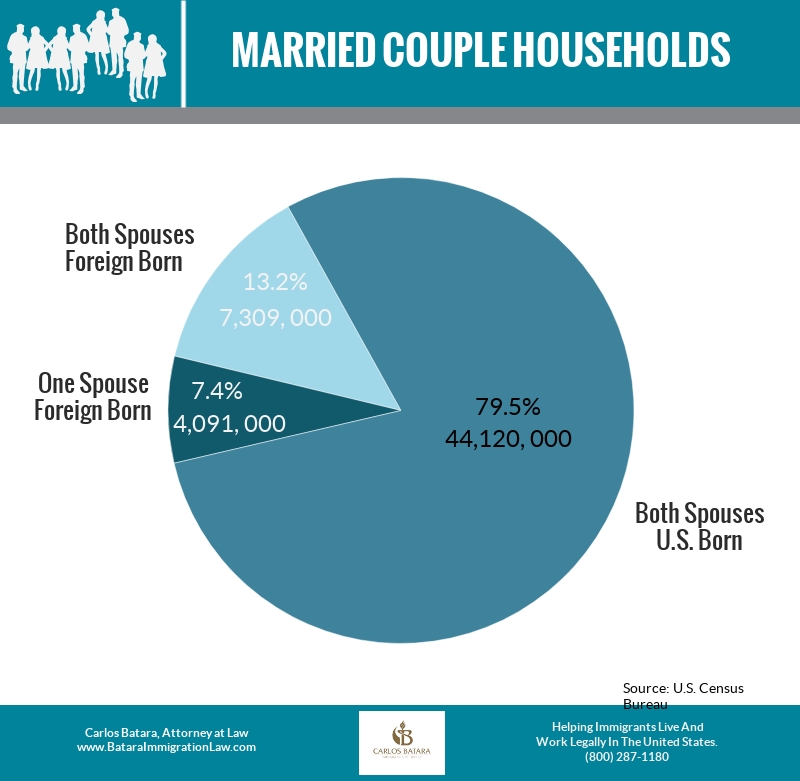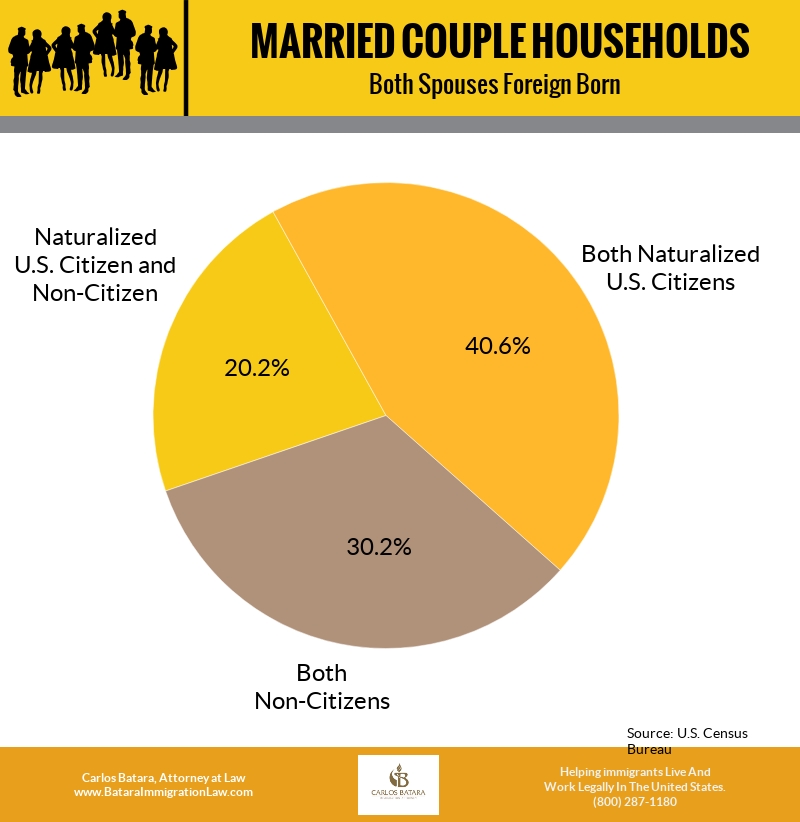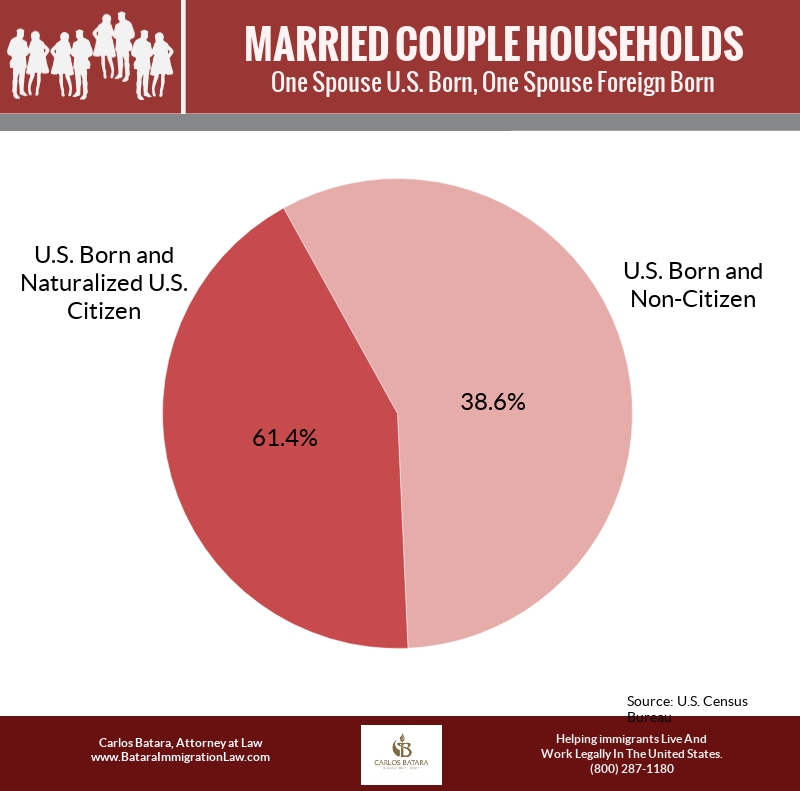
According to Kim Anderson, former President of American Families United, “U.S. citizens are the most neglected constituency in the immigration debate.”
Hyperbole aside, Anderson raises a critically significant issue that is grossly undervalued by many pro-immigrant advocates.
Simply stated, U.S. citizen spouses are far too minimized in immigration reform discourse.
And as a result of downplaying attention to the citizen spouses of immigrants, the emphasis in policy discussions which should be given to mixed-status families is diminished.
What Is A Mixed-Status Family?
A “mixed-status family” is a family whose members have different immigration status.
One example of a mixed-status family is one in which one spouse is a U.S. citizen and the other is undocumented.
Another example is where both parents are undocumented and the children were born in the United States.
(In this article, the focus is on families with mixed-status spouses.)
How U.S. Citzen Spouses Are Minimized In The Press And Social Media
Consider how public discussion of various immigration constituencies vis-à-vis the plight of U.S. citizen spouses is generally distributed in the press.
- The claims of Dreamers, undocumented immigrants who were brought into the country at an early age by parents and other adults, receive more frequent media exposure.
- The struggles of refugees arriving at our borders, in their attempt to escape horrible social, political, and economic conditions in their home countries, receive more frequent media exposure.
- The pending ordeals of Temporary Protected Status recipients, allowed to reside in the U.S. as a safe haven while conditions were not ripe for returning back to their nations of origin, whose days in the U.S. are numbered, have started to become common media stories via both print and broadcast channels.
Of course, for each of these stories, there are myriad others which do not receive half the public scrutiny they deserve – military veterans facing removal from the U.S., senior citizen immigrants unable to collect benefits from work they’ve performed for over 30 years, as well as trafficked women and children trapped in despair and poverty.
The plights of U.S. citizen spouses of immigrant husbands and wives fall into this same category of civic neglect.
This oversight leads to unfortunate circumstances not only from a practical, but also from a political, perspective.
The Ordeal Of Family Separation For Mixed-Status Immigrant Families
Here are some reasons the situation faced by U.S. citizen spouses of immigrants should be moved from the backburner to the forefront of immigration reform dialogue.
First, the number of native-born and naturalized spouses married to immigrants is far larger than any of the aforementioned immigration constituencies, including the rapidly increasing refugee population arriving at America’s border on a nearly daily basis.
Second, the community of citizen spouses married to immigrants overlaps and intersects with the various other categories of immigrants.
For instance, as a Riverside immigration lawyer, I have talked to many relatively young Dreamers, married to United States citizens, who feel trapped by the lack of a pathway to earning green cards.
In addition, hundreds of long-time TPS beneficiaries have married U.S. citizens and raised children born here. They, too, feel the dead-end nature of current family unity provisions.
Ditto for countless military veterans, senior citizen immigrants, former human slaves, and even newly-arriving refugees, all born outside the United States, now married to U.S. citizens.
Third, and perhaps most significant, of all the parties involved in the immigration debate – undocumented immigrants, permanent residents, and citizens – which group should have the strongest claim to reform?
Citizens, right?
Then why is the ordeal of U.S. citizen spouses not the highest priority for immigration reform?
Why are their mixed-status immigrant families seemingly hidden from public view?
Could this be the key to flipping the immigration debate on its head?
Certainly, it’s not an issue immigrant reform opponents want to have discussed on a widespread basis.

Family Unity For U.S. Citizen Spouses: From The Backburner To The Forefront Of Reform
Could the fact that reform is needed for mixed-status immigrant families, centered on the harm to U.S. citizen husbands and wives, be so intertwined with all aspects of immigration reform, with all immigrant constituencies, it holds the key to unlocking the immigration debate?
Could the fact that reform is needed for mixed-status immigrant families, centered on the harm to U.S. citizen husband and wives, it holds the key to winning the hearts and minds of the American public?
Could the fact that reform is needed for mixed-status immigrant families, centered on the harm to U.S. citizen husbands and wives, it holds the key of returning immigration law to its roots, a philosophical and legal understanding that family unification is the bedrock of immigration law?
Then where are all the immigrant-friendly politicians, media folks, and reform advocates when mixed-status families direly need them?
Perhaps you’re still a Pessimistic Pete type and you doubt the size of the potential political voice of U.S. citizens married to immigrants?
Okay, let’s take a closer look.
1. Total Married Couple Households In The United States
There are three possible husband – wife combinations:
- Both spouses were born in the United States
- Both spouses were born in other countries
- One spouse was born in the United States, one spouse was born in another country

As the above graph shows, there are 55,520,000 married couple households in the United States.
Of this total, 11,4000 married couple households have at least one spouse who was not born in the United States.
2. Married Coupled Households – Both Spouses Born Outside The United States
There are 7,309,000 married couple households in the U.S. where both spouses were born outside the United States.

- In 30.2% of the households, neither spouse is naturalized. The means there are 2,2017,318 married couple households where both spouses are at risk of deportation.
- In 20.2% of the households, one spouse is a citizen, one spouse is not a citizen. This equals 1,476,418 married couple households where a U.S. citizen husband or wife could lose a spouse currently at risk of deportation.
To clarify, the “at risk” label applies to both immigrants who are undocumented and those who are permanent residents. Until an immigrant is sworn in as a naturalized citizen, he or she remains susceptible to being ordered removed from the country.
3. Married Coupled Households –
One Spouse Born Inside The U.S. &
One Spouse Born Outside The U.S.
There are 4,091,000 married couple households in the U.S. where one spouse was born inside the United States and the other spouse was born outside the United States.
Of this total, in 38.6 of these married couple households, the immigrant spouse is not a naturalized citizen. This means 1,579,121 married couple households are comprised of a U.S. citizen spouse who could lose a husband or wife at risk of deportation.

Towards Green Card Pathways For Mixed-Status Immigrant Families
Taken together, these charts show that 3,055,544 U.S. citizen spouses could lose an immigrant spouse due to deportation.
Some of these immigrant spouses are likely lawful permanent residents.
As I continuously assert, these individuals need to get off the stick and seek advice on naturalization possibilities.
Others, presumably undocumented immigrants, should likewise look into their potential of winning permanent residency as a first step towards citizenship (if their spouses have not yet filed a family-based immigrant relative petition to begin the green card process).
For many, at best, their one and only option is to seek I-601A waivers based on extreme hardship, a difficult standard to meet, For others, no true options exist, and only stop-gap measures like parole for immigrant spouses offer short-term relief.
Therein lies the need for a family unity movement.
Pathways to immigration success are off limits to many mixed-status married couples.
My guess is that if these spouses could coalesce around the need for immigration reform, a force of three million United States citizens would become the strongest, loudest, and most effective pro-immigration lobby on Capitol Hill.
After all, U.S. citizens are entitled to the Constitutional guarantees of life, liberty, and the pursuit of happiness.
Unfortunately, the lack of a unified and consistent nationwide effort has undermined the efforts of grassroots advocates fighting for the rights of U.S. spouses to legal pathways to sponsor their immigrant husbands and wives.
Despite the valiant attempts by groups like Facebook’s Fair Unity (Families Advocating Immigration Reform & Unity) and American Citizens Surviving I.C.E., the task of educating non-immigrant families about the unfairness imposed on U.S. citizens having to choose between their spouses and their country is too big without more hands on deck.
Are you ready to loan yours?
By Carlos Batara, Immigration Law, Policy, And Politics




